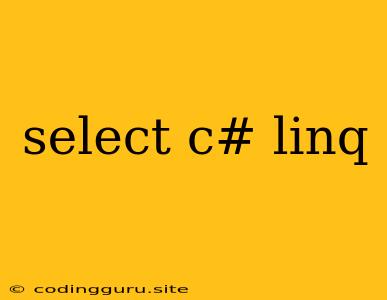Harnessing the Power of LINQ: Selecting Data with C#
LINQ, or Language Integrated Query, is a powerful feature in C# that allows you to query data in a more intuitive and efficient way. It provides a unified syntax for querying various data sources, including collections, databases, and XML files. This article delves into the core concepts of selecting data using LINQ in C#.
Why Use LINQ for Data Selection?
Traditional approaches to data selection in C# often involve loops and conditional statements. While this works, it can become cumbersome and error-prone, especially when dealing with complex data structures. LINQ offers a streamlined and expressive way to query data, resulting in cleaner and more maintainable code.
Here's how LINQ simplifies data selection:
- Declarative Approach: LINQ allows you to describe what you want to retrieve, rather than how to retrieve it. This declarative nature makes your code easier to read and understand.
- Unified Syntax: LINQ provides a consistent syntax for querying various data sources, eliminating the need to learn different querying methods for each source.
- Improved Readability: LINQ queries are often shorter and more concise than traditional loop-based approaches, enhancing code readability.
- Type Safety: LINQ leverages C#'s strong type system to ensure that the data you retrieve matches the expected data type.
The Essence of "select" in LINQ
The select keyword plays a crucial role in LINQ queries. It allows you to specify which properties or fields you want to extract from your data source. Here's a simple example:
// Sample list of products
List products = new List()
{
new Product { Id = 1, Name = "Laptop", Price = 1200 },
new Product { Id = 2, Name = "Keyboard", Price = 75 },
new Product { Id = 3, Name = "Mouse", Price = 30 },
};
// Select only the names of products
var productNames = products.Select(p => p.Name);
// Print the selected names
foreach (var name in productNames)
{
Console.WriteLine(name);
}
In this example, the Select method takes a lambda expression p => p.Name as its argument. The lambda expression specifies that we want to select the Name property from each Product object in the products list.
Going Beyond Simple Selection
The Select method offers flexibility beyond just selecting individual properties. You can:
- Project to Anonymous Types: Create new objects with specific properties without defining a separate class.
- Transform Data: Apply transformations to the selected data, such as converting data types or performing calculations.
- Filter Data: Combine
Selectwith other LINQ methods likeWhereto select data that meets specific criteria.
Example: Transforming Data
// Select product names and double their prices
var transformedProducts = products.Select(p => new { Name = p.Name, DoubledPrice = p.Price * 2 });
This code snippet selects the Name property and calculates a DoubledPrice for each product, creating a new anonymous object for each product.
Selecting from Databases
LINQ's power extends to querying data from databases. To work with databases, you'll need to use Entity Framework or other ORM tools that support LINQ integration.
Example: Selecting from a Database
// Assuming a database context named 'dbContext'
var customerNames = dbContext.Customers.Select(c => c.FirstName + " " + c.LastName);
This code selects the full names of customers from a database table named Customers.
Key Points to Remember
- Lambda Expressions: Lambda expressions are essential for defining the selection logic within LINQ queries.
- Query Syntax: While the example above uses the method syntax of LINQ, C# also offers a query syntax that resembles SQL.
- Performance: LINQ can be highly performant, but it's crucial to understand the underlying mechanisms and optimize your queries if necessary.
Conclusion
LINQ's select capability provides a robust and flexible way to select data in C#. By mastering this fundamental aspect of LINQ, you can significantly simplify and streamline your data manipulation tasks, enhancing code clarity and efficiency.
